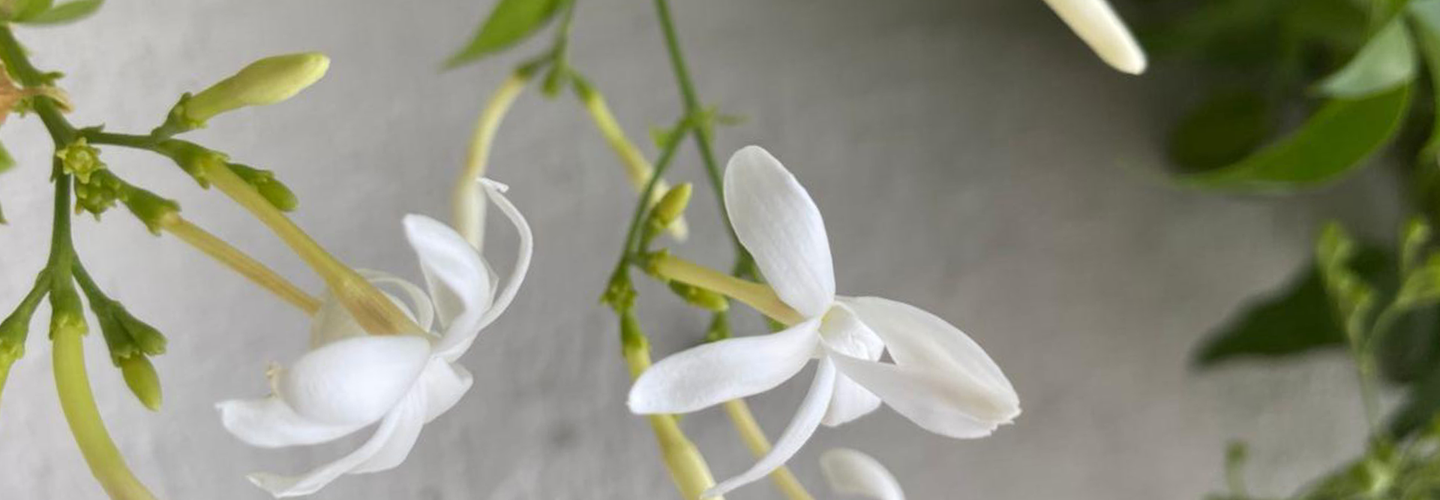When asked to name flowering plants found in the Maldives, the Jasmine plant would probably top everyone's list. However, are you picturing the same type of Jasmine as the person next to you?
Prior to developing our "Jasmine & Cinnamon" scent, we did research on the different types of Jasmine plants found locally in the Maldives. This proved to be a challenge as there are a limited number of published articles books on the topic. It is worth noting that what we have learnt is through stories told by locals, our own lived experiences and from a few articles found online.
However, we found a lot of types of Jasmine through this research and quickly realized that most people picture only 1 or 2 common types when asked about Jasmine.
In our case, it used to be the Huvandhumaa (Common Jasmine /Jasminum officinale) and the Irudheymaa (Arabian Jasmine / Jasminum sambac).
The Popular One

Photo : University of Oxford Botanic Garden and Arboretum , 2016
What was most exciting and unique about these plants, was the variety of scents that each type carried. One of the more familiar varieties, the Huvandhumaa blossoms carry a sweet scent, making it perfect to use for infusing in water and desserts.



You can watch a video on how this is braided here


Photo: maldivescook.com, 2020
We Maldivians also used it in the form of dried blossoms to flavour our tea or as a garnish that is sprinkled over traditional desserts like "Naarukufaludha". If you visit a Maldivian island, you will see this type of Jasmine growing in home gardens to be used for these reasons.

Another interesting fact about Huvandhumaa is that it is often grown in the grounds of Mosques. When asked if there was a reason for this, elderly locals recounted that it has always been grown this way. It is done so that the plants are grown on communal grounds and therefore easily accessible for the local community.
The Exotic One

Next up is the most exotic type of Jasmine; Arabian Jasmine, Jasminum sambac, or locally known as Irudheymaa. We absolutely love this type of Jasmine! It has the most incredible green, fruity and floral scent. While we are not sure if this type has a specific use locally, Irudheymaa is grown in home gardens in a lot of Maldivian islands for their beautiful aromatic white blossoms.
The Quiet One

Fun fact - in some parts of Maldives, the local name for this plant is simply -- ‘Jasmine’
UPDATE: We've found recently that this type of Jasmine is locally referred to as Maliku Bodumaa. (Ramla Abdul Ghanee, Maamelaameli)
The Special One

Compared to the many uses of Huvandhuma, Guleynooranmaa is a lesser-known type of Jasmine. Also known as the Stiff Jasmine (Jasminum volubile), this is a very special type of Jasmine to us, as this is the main source of inspiration for our “Jasmine & cinnamon” scent.

The inspiration came from our childhood memory of picking jasmine blossoms right before they bloom, just before sundown. We do this to braid them (done in a very specific technique) and pin the braids in our hair. As the sun sets, these white buds will bloom and release a beautiful aroma. This type of jasmine was grown in most houses over gates or walls specifically for their beautiful aroma. As it is a plant that grows in a vine, it makes for a perfect gate climber and an even more perfect welcome to any home!
You can watch a video on how this is braided here
We had such an exciting time learning these types of Jasmine plants and how our parents and grandparents used them. Do you have any such memory associated with Jasmine? Please share your story with us as we'd love to know about the different experiences everyone has.
If you'd like to have the scent of Jasmine & Cinnamon wafting in your homes, you can purchase one of our diffusers here
On a more important note, have we missed any other type of jasmine locally found here in the Maldives? If so please share them with us.

